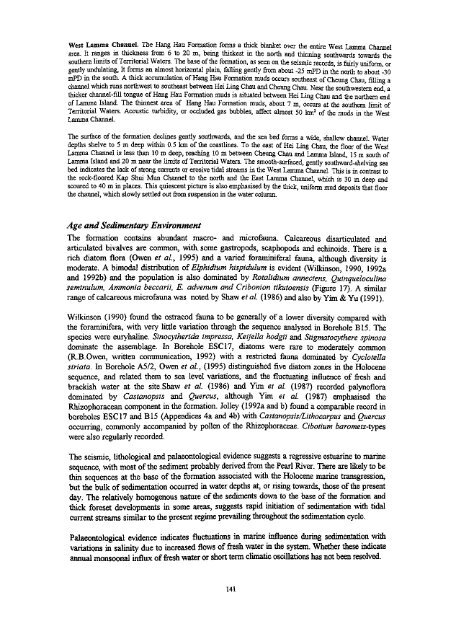1 - HKU Libraries
1 - HKU Libraries
1 - HKU Libraries
Create successful ePaper yourself
Turn your PDF publications into a flip-book with our unique Google optimized e-Paper software.
West Lamma Channel The Hang Hau Formation forms a thick blanket over the entire West Lamma Channelarea. It ranges in thickness from 6 to 20 m, being thickest in the north and thinning southwards towards thesouthern limits of Territorial Waters. The base of the formation, as seen on the seismic records, is fairly uniform, orgently undulating, It forms an almost horizontal plain, falling gently from about -25 mPD in the north to about -30mPD in the south. A thick accumulation of Hang Hau Formation muds occurs southeast of Cheung Chau ? filling achannel which runs northwest to southeast between Hei Ling Chau and Cheung Chau. Near the southwestern end, athicker channel-fill tongue of Hang Hau Formation muds is situated between Hei Ling Chau and tfte northern endof Lamma Island. The thinnest area of Hang Hau Formation muds, about 7 m, occurs at the southern limit ofTerritorial Waters. Acoustic turbidity, or occluded gas bubbles, affect almost 50 km 2 of the muds in the WestLamma Channel.The surface of the formation declines gently southwards, and the sea bed forms a wide, shallow channel Waterdepths shelve to 5 m deep within 0.5 km of the coastlines. To the east of Hei Ling Chau, the floor of the WestLamma Channel is less than 10 m deep, reaching 10 m between Cheung Chau and Lamma Island, 15 m south ofLamma Island and 20 m near the limits of Territorial Waters. The smooth-surfaced, gently southward-shelving seabed indicates the lack of strong currents or erosive tidal streams in the West Lamma Channel. This is in contrast tothe rock-floored Kap Shui Mun Channel to the north and the East Lamma Channel, which is 30 m deep andscoured to 40 m in places. This quiescent picture is also emphasised by the thick, uniform mud deposits that floorthe channel, which slowly settled out from suspension in the water column.Age and Sedimentary EnvironmentThe formation contains abundant macro- and microfauna. Calcareous disarticulated andarticulated bivalves are common, with, some gastropods, scaphopods and echinoids. There is arich diatom flora (Owen et al, 1995) and a varied foraminiferal fauna, although diversity ismoderate, A bimodal distribution of Elphidium hispidulum is evident (Wilkinson, 1990, 1992aand 1992b) and the population is also dominated by Rotalidium annectens, Quinqueloculinaseminulum, Ammonia beccarii, E. advenum and Crib onion tikutoensis (Figure 17). A similarrange of calcareous microfauna was noted by Shaw et al (1986) and also by Yim & Yu (1991).Wilkinson (1990) found the ostracod fauna to be generally of a lower diversity compared withthe foraminifera, with very little variation through the sequence analysed in Borehole B15. Thespecies were euryhaline. Sinocytherida impressa, Keijella hodgii and Stigmatocythere spinosadominate the assemblage. In Borehole ESC 17, diatoms were rare to moderately common(R.B.Owen, written communication, 1992) with a restricted fauna dominated by Cydotellastriata. In Borehole A5/2, Owen et al, (1995) distinguished five diatom zones in the Holocenesequence, and related them to sea level variations, and the fluctuating influence of fresh andbrackish water at the site.Shaw et al (1986) and Yim et al. (1987) recorded palynofloradominated by Castanopsis and Quercus, although Yim et al, (1987) emphasised theRhizophoracean component in the formation. Jolley (1992a and b) found a comparable record inboreholes ESC 17 and B15 (Appendices 4a and 4b) with Castanopsis/Lithocarpus and Quercusoccurring, commonly accompanied by pollen of the Rhizophoraceae. Cibotium barometz-typsswere also regularly recorded.The seismic, lithological and palaeontological evidence suggests a regressive estuarine to marinesequence, with most of the sediment probably derived from the Pearl River. There are likely to bethin sequences at the base of the formation associated with the Holocene marine transgression,but the bulk of sedimentation occurred in water depths at, or rising towards, those of the presentday. The relatively homogenous nature of the sediments down to the base of the formation andthick foreset developments in some areas, suggests rapid initiation of sedimentation with tidalcurrent streams similar to the present regime prevailing throughout the sedimentation cycle.Palaeontological evidence indicates fluctuations in marine influence during sedimentation withvariations in salinity due to increased flows of fresh water in the system. Whether these indicateannual monsoonal influx of fresh water or short term climatic oscillations has not been resolved.141

















